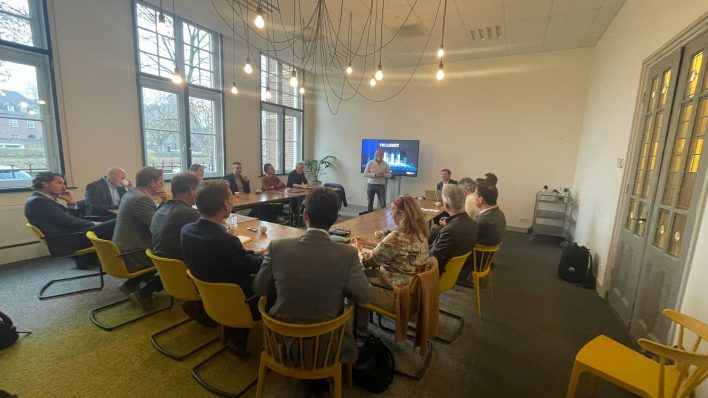Digital Twins: Paving the way for sustainable urban construction
Posted on
Urban construction in the Netherlands is facing a critical challenge: how can we build the homes and infrastructure our cities need while keeping logistics efficient, costs manageable, and environmental impact minimal? The LOKET project is tackling this issue by developing innovative tools and strategies to improve construction logistics. LOKET is part of a research program for the Ministry of Infrastructure and Water Management in the Sector Logistics, led by TKI Dinalog (Dutch Institute for Advanced Logistics). One of its most promising solutions is the use of Digital Twins, a technology that transforms how cities plan and manage their growth.
What is a Digital Twin?
Imagine a highly detailed virtual version of a city or construction site—a “Digital Twin.” This digital replica uses real-time data to mirror the physical world and predict how it might evolve.
For Den Bosch’s Innovation Quarter Den Bosch (IKDB), the Digital Twin acts as a 3D platform that visualizes material flows, tracks traffic congestion, and even calculates environmental impacts like CO2 emissions and noise pollution.
But this isn’t just a tool for visualization. The Digital Twin enables stakeholders to simulate scenarios, evaluate options, and make data-driven decisions. Its integration of real-time data streams, interactive maps, and predictive analytics makes construction logistics smarter and greener.
“Digital Twins allow us to see the big picture and the fine details simultaneously,” explains Daniel Wondyifraw, an Engineering Doctorate (EngD) trainee at JADS, working on the project. “We can test ideas and solve problems in the virtual space before they happen in the real world.”
The need for Digital Twins in urban construction
Urban areas are becoming increasingly dense, with limited space for construction and rising concerns about sustainability. As more people move to cities, managing construction logistics becomes more complex. Trucks delivering materials can cause traffic jams, noise, and pollution, all of which disrupt city life.
Current methods often rely on fragmented data and traditional logistics planning, which can’t keep up with modern challenges. Digital Twins bridge this gap by:
- Improving coordination: Bringing together all the moving parts of construction logistics into a single, easily accessible platform.
- Enhancing decision-making: Simulating scenarios, like material delivery times, to optimize efficiency and sustainability.
- Supporting sustainability goals: Monitoring simulated CO2 emissions and noise pollution, visualizing traffic patterns to identify eco-friendly routes, and providing actionable insights to reduce environmental impact. Future improvements, including biodiversity tracking and advanced route planning, will be added.
“Cities can be thought of as living systems,” says Professor Jos van Hillegersberg, Scientific Director at JADS. “Digital Twins help us understand and manage these systems dynamically, making urban life more sustainable and efficient.”
Milestones in the LOKET Project
Since its start, the LOKET project has made great strides. Daniel has:
- Developed a prototype Digital Twin for the Innovation Quarter Den Bosch (IKDB), leveraging advanced tools like 3D BAG datasets (a detailed map of 10 million buildings in the Netherlands) and GIS systems.
- Integrated real-time traffic data to analyze congestion and plan optimized logistics routes.
- Integrated real-time weather forecasts, Air Quality Index (AQI), and streamed sensor data for CO2 and noise levels to effectively monitor construction activities in IKDB.
- Collaborated closely with stakeholders such as TNO, Heijmans, Kadaster, Microsoft, and local government to refine use cases and ensure the solution addresses real-world challenges.
One highlight of the project is its use of real-time data sources, like TomTom traffic APIs, to simulate the best routes for construction vehicles. This reduces disruption in the city and reduces CO2 emissions—an important step toward zero-emission urban logistics.
Challenges
As with any innovative project, challenges are inevitable. One key issue is the availability and quality of data. Urban logistics data is often fragmented or outdated, making it challenging to create a fully accurate and dynamic Digital Twin. To address this, Daniel is working with open data platforms like Nationaal Dataportaal Wegverkeer and integrating additional sources, such as air quality sensors and IoT devices, to enhance the Digital Twin’s accuracy and reliability.
Another challenge is convincing all stakeholders, including city planners and construction companies, of the value Digital Twins can bring. The project focuses on demonstrating real-world benefits, such as more efficient logistics, cost savings, and better sustainability outcomes, to build trust and support for the technology
The potential of Digital Twins
The potential of Digital Twins extends far beyond construction. For municipalities, they offer a way to manage city operations more effectively. For businesses, they provide tools to optimize logistics and reduce costs. For environmental agencies, they offer insights into sustainability impacts. And for academic institutions like JADS, they open up new avenues for collaboration and research.
Looking ahead
The next steps in the LOKET project include refining the Digital Twin prototype, integrating additional data streams, and enhancing dashboards and analytics. AI-powered features and machine learning models will be incorporated to provide predictive insights, supporting real-time construction logistics. By 2026, the Digital Twin will serve as a critical tool for optimizing and coordinating construction activities in the IKDB.
See the Digital Twin in action
To see the potential of Digital Twins in action, watch Daniel’s video presentation. It offers a detailed look at the technology behind the project and how it’s transforming urban construction logistics.
By bringing together academia, industry, and government, initiatives like the LOKET project showcase how data science can address pressing societal challenges, paving the way for smarter, more sustainable cities.
About the EngD Program
Designed for talented professionals like Daniel, the two-year EngD program combines cutting-edge research with practical application, preparing graduates to tackle complex challenges in data science and beyond. Learn more about the EngD program and its potential to drive innovation on the EngD page



